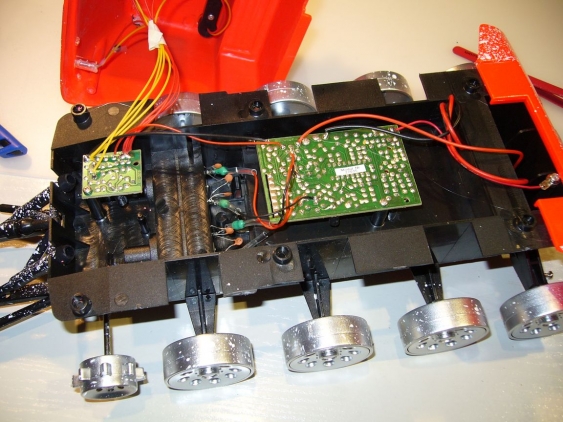« Measuring the performance of the wireless power demo kit - an update
| Main |Wireless power contest - strategies for charging a battery pack, part1 »
Wireless power contest - outlining the basic plan
After I changed plans for last week, and did a second round of measurements, its now about time to write a little bit more about the actual project.
The basic idea is to augment an existing RC car by removing its battery pack, and to replace it with a Li-Ion battery. This battery then should get charged by wireless power transfer. Then its enough for my son to just take the car, put it on the charger station before going to sleep, and it should be ready the next day.
What it looks like
Opening the snow groomer reveals that there is already a significant amount of electronics inside:
The large board contains the RC receiver and the motor control, and the small one is just a oscillator with controls two small lamps in the cockpit. Unfortunately this setup doesn’t leave too much room for my own electronics. Especially since I don’t want to modify much of it, to be able to use it in its original form in case something goes wrong. So I would like to be able to just plug in the original battery pack and have it working.
A plan begins to emerge
So lets have a look what needs to be done.
First, what do we have right now? The car is powered by a battery pack (consisting of 8 AA cells, so its 12 V), which is connected with a Tamiya connector to the rest of the electronics. The battery pack itself can be removed, leaving just a nice cave which might be used later on. The electronics are disconnected by a mechanical switch (at the bottom of the car), so its not drawing any current when not in use. When switched on, the circuit is drawing 150 mA just in standby. This is due to the receiver running, and blinking the lamps (there are peaks of 500 mA due to them being incandescent lamps).
Turning on one of the motors increases the current to about 0.5 A when running alone, with a peak current of 2.5 A during startup (for a very short amount, and about 1 A for a briefly longer period). Running both motors together draws, as expected, about 1 A, with a startup current of 3 A (its not the double current of a single motor, I think this is due to the internal resistance of the batteries). When both motors get under load (e.g. by blocking them with my hand) they draw about 1.4 A together.
So this gives some basic figure about the current consumption. AA cells have a usable voltage range starting with 1.5 V when fresh, down to about 1 V (maybe down to 0.9 V, but I doubt that they then can deliver enough current for the motors). This gives a voltage range for the battery pack from 8 up to 12 V. This is much higher than a single Li-ion battery can deliver.
So this gives two possible options, shown in the diagram above: either use a single Li-ion battery and step up its voltage, or use multiple batteries as battery pack.
The single battery solution
In terms of charging, using a single battery is the easiest solution. One can directly use the 5 V provided by the wireless receiver, and get charge the battery with a linear regulator. Also, there are plenty of solutions for controlling the charge process (e.g. the LTC4054-4.2 I have used before. For charging with higher currents, switch-mode chargers are available too.
There are also several boost converters available for doing the voltage step-up conversion. But it would need to provide 18 W of output power (12 V at 1.5 A), with a peak output of twice that. This limits the selection already quite a bit, and also introduces the problem of heat management. Also, the battery would need to provide a continuous current of 5 A or more (during startup it would be about 10 A if delivered by the converter). Both the boost converter and the battery most likely won’t be small, and might get expensive. Also, if the converter is always connected to the battery it would need to have a really small quiescent current (single digit µA). Since this will be even harder, I would need to place the converter after the switch. But this then spoils my goal of not doing any modifications.
So going this route seems not to be the right one.
Using multiple batteries
Since the usable voltage range of the original battery pack goes from 8 up to 12 V, using three Li-ion batteries is an almost match: using a cutoff at 3 V they give a voltage range from 9 up to 12.6 V (or a little bit less if they get not charged fully).
So compared to a single battery I can spare the DC/DC converter, which also satisfies the ‘no modification’ requirement. Also, the current requirements are much easier to fulfill - the batteries only need to deliver the 1.4 A the motors draw under load. I think the startup current of 3 A can be handled by adding a bulk capacitor. That means the batteries will+ probably much cheaper (and hopefully also smaller)
On the other hand, charging a battery pack is much more complicated than a single battery. Since each of the single cells can be in a different charge/discharge state (with different voltage and remaining capacity), each one needs to be monitored separately. Also, the cells need to be balanced during charge - meaning that cells being already full are not charged anymore, while other cells are still charged (since they are in series). Either that, or I need a way to charge all cells separately.
So with this solution I’m moving complexity from the discharge state (by using a boost converter) to the charge state (by using separate cell monitoring and balancing). But whats more important: the efficiency (or rather inefficiency) moves with that. By using multiple batteries and connect them directly to the load, I can use their full capacity, without wasting energy in the boost conversion process. Wasting it instead during charge just means this process will take a littler bit longer, but that is a trade-off I can live with.
Other requirements
Another feature I will add is an under-voltage-lockout. That means as soon as the battery voltage falls below a certain threshold (around 2.9 V per cell), the load is disconnected. This ensures that the batteries are not discharged too deep. Most Li-ion batteries have their own internal UVLO, but its typically set at a point just before the battery takes permanent damage - but it already might suffer capacity reduction. So I want to stay a littler bit higher than that. Using multiple batteries ins series means I need to monitor all batteries in the stack, and switch off all even if only one falls below the threshold.
It goes without saying that all circuity permanently connected to the batteries (the UVLO function and the cell balancer) need to draw as low a current as possible. My target is an overall consumption of less than 10 µA. Assuming a remaining capacity of just 10 mAh (being mostly dead) this still gives about 1000 hours (or 40 days) of function before the batteries switch off by themselves (and might suffer from that).
Conclusions and further plans
Having now settled the basic architecture of my system, the next step is working on the charging and balancing mechanism. This will be the most complex part of this project. So the next post (maybe even multiple ones) will take a look at possible solutions of charging multiple batteries. And who knows, maybe there will be additional rounds of measuring something…


